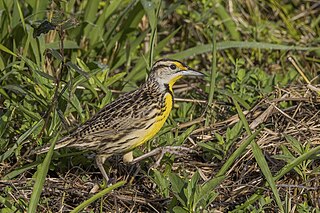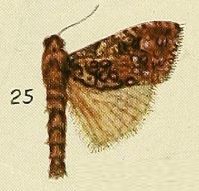
The bongo is a large, mostly nocturnal, forest-dwelling antelope, native to sub-Saharan Africa. Bongos are characterised by a striking reddish-brown coat, black and white markings, white-yellow stripes, and long slightly spiralled horns. It is the only tragelaphid in which both sexes have horns. Bongos have a complex social interaction and are found in African dense forest mosaics. They are the third-largest antelope in the world.

The eastern meadowlark is a medium-sized blackbird, very similar in appearance to sister species western meadowlark. It occurs from eastern North America to northern South America, where it is also most widespread in the east. The Chihuahuan meadowlark was formerly considered to be conspecific with the eastern meadowlark.

The warbling vireo is a small North American songbird.

The willow flycatcher is a small insect-eating, neotropical migrant bird of the tyrant flycatcher family native to North America.

The red-bellied paradise flycatcher, also known as the black-headed paradise flycatcher, is a medium-sized passerine bird of the family of monarch flycatchers. It is native to intra-tropical forests of Africa. The male bird is about 17 cm (7 in) long and has a black head, a mainly chestnut body, and a tail with streamers nearly twice as long as the body. The colouring is somewhat variable across the bird's range. Both females and juveniles lack the tail streamers and are a duller brown colour. It is closely related to the African paradise flycatcher, and the two can hybridise.

The Scaphiopodidae are a family of American spadefoot toads, which are native to North America. The family is small, comprising only seven different species.

Swinhoe's snipe,, also known as forest snipe or Chinese snipe, is a medium-sized, long-billed, migratory wader.

The pink-billed lark is a species of lark in the family Alaudidae found in southern Africa. Its natural habitat is subtropical or tropical dry lowland grassland.

The grey-backed sparrow-lark or grey-backed finch-lark is a species of lark in the family Alaudidae. It is found in southern and south-central Africa. Its natural habitats are subtropical or tropical dry shrubland and subtropical or tropical dry lowland grassland. Sometimes, the name 'grey-backed sparrow-lark' is also used to describe the black-eared sparrow-lark.

The bristlebirds are a family of passerine birds, Dasyornithidae. There are three species in one genus, Dasyornis. The family is endemic to the south-east coast and south-west corner of Australia. The genus Dasyornis was sometimes placed in the Acanthizidae or, as a subfamily, Dasyornithinae, along with the Acanthizinae and Pardalotinae, within an expanded Pardalotidae, before being elevated to full family level by Christidis & Boles (2008).

The western yellow robin is a species of bird in the Australasian robin family, Petroicidae, native to Australia. Described by John Gould in 1838, the western yellow robin and its Australian relatives are not closely related to either the European or American robins, but they appear to be an early offshoot of the Passerida group of songbirds. Ranging between 13.5 and 15.5 cm long, it has grey upperparts, and a grey breast and head, broken by whitish streaks near the bill and below the eye, with a conspicuous yellow belly. The sexes are similar in appearance. Two subspecies are recognized: subspecies griseogularis, which has a yellow rump, and subspecies rosinae with an olive-green rump.

The jacky winter is a small grey-brown robin found commonly throughout Australia and also in Papua New Guinea. The jacky winter acquired its name due to rapid and strong vocalisations, which sound like jacky-jacky winter-winter. Their call is also often referred to as sounding like peter-peter-peter. Its habitats include open woodlands and farmlands.

Hemiphlebia mirabilis, commonly known as the ancient greenling, is a species of damselfly, the only living species of the genus Hemiphlebia and the family Hemiphlebiidae. It is very small with a long, metallic-green body and clear wings. It is endemic to south-eastern Australia. Its natural swamp habitat is threatened by habitat loss. The oldest representatives of the family date to the Late Jurassic.
Moyencharia is a genus of moths belonging to the family of Cossidae, Metarbelidae.
Moyencharia mineti is a moth of the family Cossidae. It is found in southern Chad and probably also the Central African Republic. The habitat consists of a mosaic of riparian forests, open woodland and wooded floodplain grassland at low elevations.
Moyencharia joeli is a moth of the family Cossidae. It is found in north-central and north-east central Nigeria and probably north-western Cameroon. The habitat consists of a mosaic of wooded farmland and drier peripheral semi-evergreen Guineo-Congolian rain forests and riparian forests at low elevations.
Moyencharia winteri is a moth of the family Cossidae. It is found in south-western Sudan and the north-eastern part of the Democratic Republic of the Congo. The range probably extends into the Central African Republic. The habitat consists of a mosaic of wooded farmland, swampy sites, savanna with drier peripheral semi-evergreen Guineo-Congolian rain forests and riparian forests at low elevations.
Moyencharia sommerlattei is a moth of the family Cossidae. It is found in Guinea. The habitat consists of various forest types at low elevations.
Moyencharia ochreicosta is a moth of the family Cossidae. It is found from western Burkina Faso south through north-eastern and south-eastern Ghana to south-eastern and east-central Nigeria. It is probably also present in Togo and Benin. The habitat consists of rain forests and riparian forests at low elevations.

The Metarbelidae are a family of the Cossoidea also called the carpenter or goat moths, and is sometimes treated as a subfamily, Metarbelinae of the Cossidae. No synapomorphies are shared with the Cossidae based on adult morphology. The family Metarbelidae was first described by Embrik Strand in 1909.












